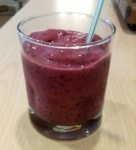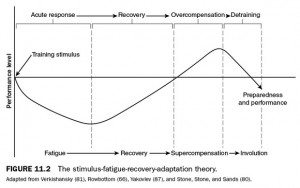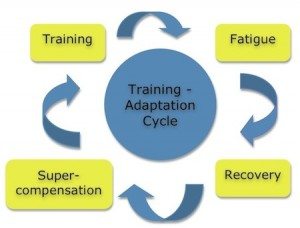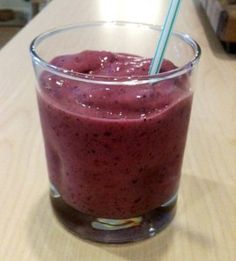Many of us enjoy riding hard: climbing steep grades, pushing huge gears on the flats and trying to put our riding buddies into difficulty at every opportunity. But that desire, along with unusually strong work ethic possessed my most cyclists can be a doorway to damnation: overtraining can rear its ugly head. The key to preventing overtraining, as well as seeing marked improvement may not be your workouts, but what you do in between them.
Check out the post recovery tips after the break and learn how to get stronger and faster by resting and recovering harder.
 What Happens During Post Workout Recovery
What Happens During Post Workout Recovery
To understand what happens during recovery, perhaps we need to know what happens during exercise first. This can be best described by the phrase “training breaks the body down, resting builds it back up.”
When we exercise the training stress creates a stimulus and recovery overcompensates to prepare your body for further stimulus. Your body wants to work less the next time it is called upon to perform an exercise. In the case of hard cycling, glycogen stores are depleted, enzymes are depleted, muscle tissue suffers micro-damage, our mental state deteriorates and we may even suffer more notable maladies like saddle sores, joint pains and tendon pulls. All these issues can add up over time, and if adequate recovery isn't taken, the accumulated fatigue will eventually cause a decrease in performance as well as other symptoms such as irritability, increased sickness, depression and run down feelings.
 Recovery is the process by which the body rebuilds the damage done during hard training and if training stimulus was great enough, the body will build itself up stronger than it was previously. During recovery, muscle and liver glycogen is restored, muscular micro-damage is repaired, mental states are refreshed and issues like saddle sores have a chance to heal. Physiological changes occur as well, such as an increase in aerobic enzymes, increase in mitochondrial density (energy producing organelles in muscle tissue), increase in capillary density in muscles, increase in red blood cell and plasma production and muscle hypertrophy. With how important these processes are to increased performance, how much recovery is needed to push fitness gains higher during the next workouts?
Recovery is the process by which the body rebuilds the damage done during hard training and if training stimulus was great enough, the body will build itself up stronger than it was previously. During recovery, muscle and liver glycogen is restored, muscular micro-damage is repaired, mental states are refreshed and issues like saddle sores have a chance to heal. Physiological changes occur as well, such as an increase in aerobic enzymes, increase in mitochondrial density (energy producing organelles in muscle tissue), increase in capillary density in muscles, increase in red blood cell and plasma production and muscle hypertrophy. With how important these processes are to increased performance, how much recovery is needed to push fitness gains higher during the next workouts?
Post Workout Recovery Planning
Ideally, cyclists would have an easy day or complete rest day after every hard ride, but generally this neither creates enough training stimulus nor satisfies the mental desire to spend time on the bike. In this case, the athlete may need to have back to back hard days followed by a rest day. For example, someone training 5 days per week (centered around the weekend) may have the following schedule:
- Monday – hard
- Tuesday – rest
- Wednesday – hard
- Thursday – hard
- Friday – rest
- Saturday – hard
- Sunday – hard
- Monday – rest
- Tuesday – hard
- Wednesday – rest
- Thursday – hard
- Friday – rest
- Saturday – hard
- Sunday – hard
In this case, rest days are more plentiful and break up workouts in such a way that intensity can be higher during each workout. Remember that you don't have to stick to this schedule religiously; if you have commitments that prevent you from riding on one specific day, maybe you'll sandwich two days together, riding hard for two days and recovering for two days. Be careful that your training days don't burn you out before you recover, though.
Now that we have an idea of what a recovery schedule looks like, let's see what it looks like in terms of planning a week of riding:
- Monday – rest – 1 hour recovery ride, very easy intensity/RPE (Rating Perceived Exertion) scale 1-2
- Tuesday – hard – Group ride over flat to rolling terrain, RPE 6-8
- Wednesday – rest – off bike or yoga
- Thursday – hard – Solo or group climbing ride with intervals, RPE 7-10
- Friday – rest – 1 hour recovery ride, very easy, RPE 1-2
- Saturday – hard – Group ride OR longer distance ride over rolling terrain RPE 7-9
- Sunday – hard – Group ride OR longer distance ride over rolling terrain RPE 6-9

How Much Post Workout Recovery Is Enough?
The easiest way to know if you're recovered is to actually listen to your own body. While this takes a while to get really good at, you can easily begin by taking note of how you feel when you get out of bed in the morning. Sluggish or heavy feeling legs, stiffness and soreness when climbing stairs and lingering muscle aches are telltale signs that you may need an extra rest day. These feelings may persist longer as we age, since recovery seems to be hindered as the body ages; you may not be able to do that three day block without taking two rest days as you get older. But even if you feel good and you've got a workout scheduled, you may end up aborting it if you're not properly recovered.
If you go out to ride a hard workout and you just can't seem to produce normal speed and/or power, or your legs feel achy and tired, you may be better off bagging the workout and just taking an easy spin through the neighborhood. There's no sense in struggling through a workout when you clearly should be resting; the biggest benefits from workouts come when the body is refreshed. If you insist on a workout with fatigued legs, you'll only eke out mediocre gains while piling on more fatigue.
Finally, there may be occasions where you'll need to take more extended rest. You may have an important race coming up or you may just have piled on three or four weeks of heavy training and need some downtime. That week may look like this:
- Monday – hard – Group ride over flat to rolling terrain, RPE 6-8
- Tuesday – rest – 1 hour recovery ride, very easy intensity RPE 1-2
- Wednesday – rest – off bike or yoga
- Thursday – hard – Solo or group ride, RPE 5-8
- Friday – rest – 1 hour recovery ride, very easy, RPE 1-2
- Saturday – rest – 1 hour recovery ride, very easy, RPE 1-3, (add couple of short intervals to open up the legs, keep them loose and get heart rate up for a short period)
- Sunday – race – “balls to the wall, win or bust”
Post Workout Recovery Supplements
Don't forget to share this information with your friends, share on twitter or like/share on Facebook!
